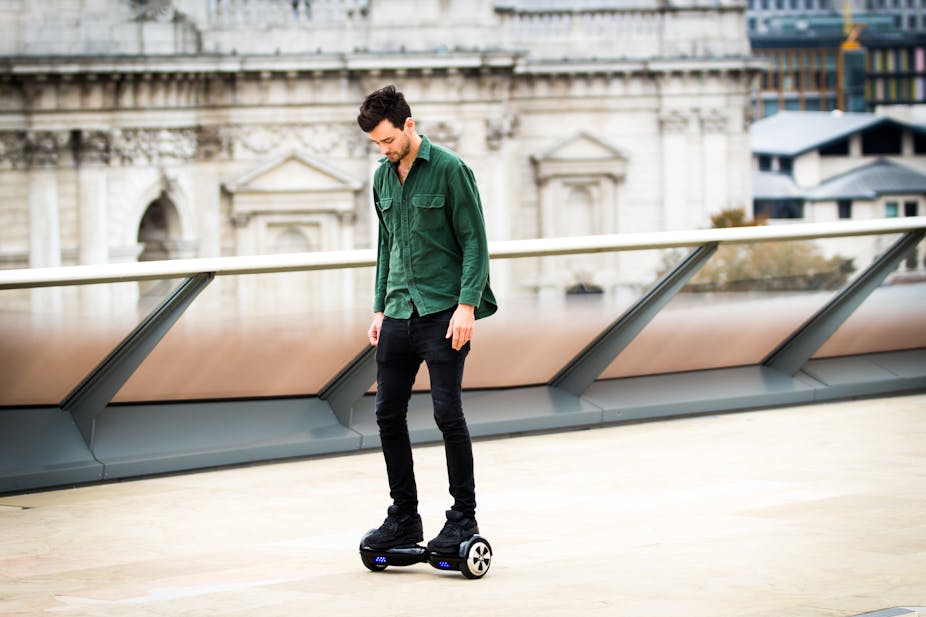Walking across campus to my office each morning this semester, I’ve found it hard to ignore the growing number of students using hoverboards to get around. These two-wheel self-balancing boards (they don’t really hover, Back-to-the-Future-style) are one of the hottest gadgets this holiday season.
I’m probably just being a curmudgeon, but my first reaction as I saw students hoverboarding between classes was “Why?!”
As sedentary lifestyles continue to be a major underlying factor in chronic conditions like type 2 diabetes and heart disease, I wondered whether these trendy two-wheelers are simply another way to avoid the exercise we all need to stay healthy. After the novelty wears off, will hoverboards become just one more device we use to cut activity out of our daily lives?

Perhaps not surprisingly, there’s pretty much nothing known yet about the relative merits of hoverboarding compared to walking between locations (or in the case of many students, skateboarding). The technology’s cool-appeal is still way ahead of questions like “Is it healthy?”
And as it turns out, chronic disease is currently the least of the budding hoverboarder’s worries. Over the past few months, videos of hoverboard slips and spills have become rife. These are amusing enough, if you’re into watching other people’s pratfalls. But they also illuminate a problem of serious injury from inexpert board use.
In a quick analysis of health care service provider records, pediatrician Hannah Galvin found a sharp upturn in patients seen for hoverboard incidents from September to November this year. Many of these were associated with teenagers. And a US Consumer Product Safety Commission (CPSC) spokesperson recently flagged a rapid rise in hoverboard-related hospital visits, in an interview with CBS News.
And this is not just a US issue. Tragically, a teenager riding a hoverboard was hit and killed by a bus in London recently. And in the UK, the organization Citizens Advice recently tweeted that they’d dealt with 250 problems in December alone.
Hoverboard injuries have become such a prominent issue that Elliot Kane, chairman of the CPSC, recently issued a statement saying, “I do not want to downplay the fall hazard.” The statement went on to emphasize the importance of wearing safety gear when using hoverboards – something that doesn’t seem to have trickled down to most users yet.
Kane’s statement also highlights a more visible hoverboard hazard, though – and one that’s been dominating the media over the past few weeks: the possibility of your cherished board spontaneously going up in flames.
The trouble, it seems, lies with the less-than-safe lithium-ion (Li-ion) batteries that some models use. Overcharging, physical stress or shorting can lead to these overheating and rupturing, sometimes with disastrous consequences.
Despite the novelty of hoverboards, the dangers of Li-ion batteries are not new. Over the years, they’ve been responsible for fire hazards in products ranging from laptop computers to the Boeing 787 Dreamliner. They’re a technology that, if used responsibly, is reasonably safe. But they’re highly susceptible to becoming a safety risk if shoddily made, misused or mistreated.
It may turn out that hoverboards demand better Li-ion battery design and use standards for them to remain safe, and that what we’re now seeing are the early warnings of not-quite-there technology. Or it may simply be that some unscrupulous companies are cutting corners to cash in on consumer demand.
Either way, it’s likely that recalibration of regulations and guidelines around hoverboard use will eventually lead to increased safety over time – hopefully without too many people being injured in the process.

It may be that, once the safety issues are ironed out, hoverboards will be no worse health-wise than walking to where you’re going. And as a bonus, they may provide unusual ways of getting your workout in.
For instance, hoverboard user Justin Rankin suggests that riding one isn’t as passive as it might seem. “Even when I’m standing on the hoverboard doing absolutely nothing, I can feel muscles firing and increased heart rate,” he writes in a recent blog at LAGlyders.
And searching YouTube for “Hoverboard workouts” reveals a growing – if occasionally bizarre – catalog of ways in which people are using these devices to keep fit!
Whether the workout you get while hoverboarding from A to B is comparable to a brisk walk remains to be seen. I still wonder whether the desire to get around faster, and with less effort, doesn’t take just a little away from the simple pleasure of taking a few minutes to stretch your legs.
Then again, maybe I’m just showing my age.

